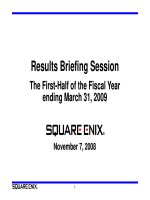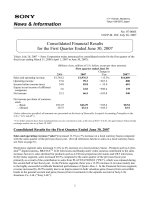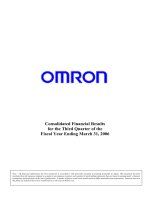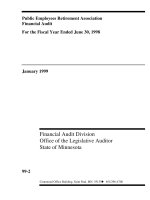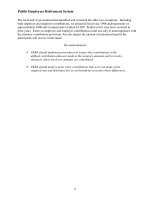Consolidated Financial Results for the Third Quarter of the Fiscal Year Ending March 31, 2006 pot
Bạn đang xem bản rút gọn của tài liệu. Xem và tải ngay bản đầy đủ của tài liệu tại đây (213.67 KB, 14 trang )
Consolidated Financial Results
for the Third Quarter of the
Fiscal Year Ending March 31, 2006
Note: All financial information has been prepared in accordance with generally accepted accounting principles in Japan. This document has been
translated from the Japanese original as a guide to non-Japanese investors and contains forward-looking statements that are based on managements’ estimates,
assumptions and projections at the time of publication. A number of factors could cause actual results to differ materially from expectations. Amounts shown in
this financial statement have been rounded down to the nearest million yen.
1
Summary of Consolidated Financial Results for the Third Quarter of the Fiscal Year
Ending March 31, 2006
OMRON Corporation (6645)
Exchanges Listed: Tokyo, Osaka, Nagoya Stock Exchanges, First Section
Principal Office: Kyoto, Japan
Homepage:
htto://www.omron.com
Representative: Hisao Sakuta, President and CEO
Contact:
Masaki Haruta, General Manager, Corporate
Planning Division,
Financial and Accounting Department
Telephone: +81-75-344-7070
1. Preparation of Summary Third-Quarter Fiscal 2006 Results
Simplification of accounting methods:
Yes. Some simplified methods are applied in accounting
standards for reserves and allowances.
Changes in consolidated accounting methods
from the most recent fiscal year:
Yes. (Change in the measurement date of projected benefit
obligation and pension plan assets in pension accounting)
(Change in segment classification in geographical segment
information)
Changes in scope of consolidation and
application of equity method:
Yes
Consolidation:
(New) 10 companies
(Eliminated) 9 companies
Equity Method:
(New) 2 companies (Eliminated) 4 companies
2. Consolidated Financial Results for the Third Quarter of the Fiscal Year Ending March 31,
2006
(1) Sales and Income
Millions of Yen - Except Per Share Data and Percentages
Nine months ended
December 31, 2005
Nine months ended
December 31, 2004
Year ended
March 31, 2005
Change Change
Net sales 442,755 (1.5)
449,607
7.9 608,588
Operating income 44,009 (4.0)
45,845
22.8 56,111
Income before income taxes 47,059 9.2 43,111
23.9 52,548
Net income 26,161 5.4 24,819
45.1 30,176
Net income per share (yen) 110.25 103.99 126.52
Net income per share, diluted (yen) 110.21 102.07 124.75
Note: Percentages for net sales, operating income, income before income taxes, and net income represent changes
compared with the same period in the previous fiscal year .
2
(2) Consolidated Financial Position
Millions of Yen - Except Per Share Data and Percentages
As of
December 31, 2005
As of
December 31, 2004
As of
March 31, 2005
Total assets
557,072 573,275 585,429
Shareholders’ equity
362,894 306,780 305,810
Shareholders’ equity ratio (percentage)
65.1 53.5 52.2
Shareholders’ equity per share (yen)
1,548.47 1,288.60 1,284.81
(3) Consolidated Cash Flows
Millions of Yen - Except Per Share Data and Percentages
Nine months ended
December 31, 2005
Nine months ended
December 31, 2004
Year ended
March 31, 2005
Net cash provided by operating activities
24,752 36,449 61,076
Net cash used in investing activities
(31,289) (27,548) (36,050)
Net cash used in financing activities
(26,296) (35,991) (40,684)
Cash and cash equivalents at end of period
49,699 68,831 80,619
3. Projected Results for the Fiscal Year Ending March 31, 2006
(April 1, 2005 – March 31, 2006)
(Unchanged from figures announced on October 30, 2005)
Millions of Yen
- E
xcept per Share
Full Year Ending
March 31, 2006
Net sales
625,000
Income before income taxes
63,000
Net income
36,000
Net income per share (yen)
153.61
Note: Please see page 6 of the attached materials regarding assumptions of the results projected
above and cautionary statements concerning the use of these projections.
3
January 30, 2006
Omron Corporation
Summary of Results for the Nine Months Ended December 31, 2005
Consolidated Results
(U.S. GAAP) (Millions of yen, %)
Nine months
ended
December 31,
2005
Nine months
ended
December 31,
2004
Year-on-
year change
Year ended
March 31,
2006
(projected)
Year ended
March 31,
2005
(actual)
Year-on-
year change
Net sales 442,755
449,607
(1.5%) 625,000 608,588 2.7%
Operating income
[% of net sales]
44,009
[9.9%]
45,845
[10.2%]
(4.0%)
[-0.3P]
65,000
[10.4%]
56,111
[9.2%]
15.8%
[+1.2P]
Income before income taxes
[% of net sales]
47,059
[10.6%]
43,111
[9.6%]
9.2%
[+1.0P]
63,000
[10.1%]
52,548
[8.6%]
19.9%
[+1.5P]
Net income 26,161
24,819
5.4% 36,000 30,176 19.3%
Net income per share (basic) (¥) 110.25
103.99
+6.26 153.61 126.52 +27.09
Net income per share (diluted) (¥)
110.21
102.07
+8.14 124.75
Return on equity (%) 10.7% 10.4% (+0.3P)
Total assets 557,072
573,275
(2.8%) 585,429
Shareholders’ equity
[Shareholders’ equity ratio]
362,894
[65.1%]
306,780
[53.5%]
18.3%
[+11.6P]
305,810
[52.2%]
Shareholders’ equity per share (¥)
1,548.47
1,288.60
+259.87 1,284.81
Cash flows from operating
activities
24,752
36,449
(11,697)
61,076
Cash flows from investing
activities
(31,289)
(27,548)
(3,741)
(36,050)
Cash flows from financing
activities
(26,296)
(35,991)
9,695
(40,684)
Cash and cash equivalents at end
of period
49,699
68,831
(19,132)
80,619
Notes:
1. Quarterly results have not been reviewed by an independent auditor.
2. Includes 143 consolidated subsidiaries and 15 affiliated companies accounted for by the equity method.
3. Figures for the nine months ended December 31, 2005 and the forecast for the year ending March 31, 2006 include transfer of
substitutional portion of employees’ pension fund totaling ¥11,915 million.
4. The ATM and other information equipment business was transferred to an affiliate accounted for using the equity method on
October 1, 2004.
4
(Attachment)
1. Results of Operations and Financial Condition
General Overview
Reviewing economic conditions during the first three quarters (the nine months ended December
31, 2005) of the Omron Group’s fiscal year, the U.S. economy continued to expand steadily due to
firm consumer spending, stabilized corporate earnings and other factors. Since summer, the European
economy has shown a moderate recovery trend overall due to factors including improved hiring
conditions. As for Asian economies, China maintained a high growth rate despite a slight slowdown
in consumer spending and capital investment, and the economies of other countries were strong
overall. Japan’s economy is also in a moderate recovery trend, with increasingly robust capital
investment and hiring, supported by corporate earnings that are beginning to show a rebound, and the
impact of these factors on household spending.
In this economic environment, the Omron Group’s third-quarter net sales totaled ¥442,755 million,
a 1.5 percent decrease from the same period in the previous fiscal year. The decrease reflected the
substantial effect of the transfer of the ATM and other information equipment business to an equity
affiliate in October 2004. However, despite a weak market for consumer and commerce components
for IT and digital-related products caused by inventory adjustments that persisted until the first half of
the fiscal year, net sales excluding the transferred information equipment business increased 4.8
percent over the same period in the previous fiscal year as a result of steady sales growth of factory
automation control systems, automotive electronic components and other core Omron Group
products supported by firm demand from capital investment.
As for income, with the decrease in net sales due to the transfer of the information equipment
business, operating income decreased 4.0 percent from the same period in the previous fiscal year to
¥44,009 million. However, income before income taxes was ¥47,059 million (a 9.2 percent increase
from the same period in the previous fiscal year) and net income was ¥26,161 million (a 5.4 percent
increase from the same period in the previous fiscal year).
Results by Business Segment
Industrial Automation Business
In Japan, sales of the safety business and quality solutions business, which Omron has positioned as
strategic growth businesses, remained firm from the first half of the fiscal year, in addition to a
recovery in sales of products for the semiconductor and digital appliance industries, which are
emerging from an inventory adjustment phase. As a result, overall domestic sales increased from the
same period in the previous fiscal year.
Overseas, sales of products to the automobile industry in North America increased, as did sales of
inverters and servomotors in Europe. Foreign currency translation also helped increase sales. Sales
were strong in Southeast Asia and Greater China, where exports continue to grow briskly.
As a result, segment sales were ¥198,984 million, a 6.1 percent increase from the same period in
the previous fiscal year.
Electronic Components Business
In Japan, overall sales of products such as relays for air conditioners and electronic components for
the amusement industry were weak due to inventory adjustments in the consumer and commerce
industry that have continued from the second half of the previous fiscal year. In addition, sales of
backlights for mobile phones and large-screen LCD televisions were down due to intensifying price
competition.
Overseas, sales in the growing field of products for the IT and mobile phone market began to
increase as a result of Omron’s efforts to strengthen sales and marketing in the United States and
Europe and to expand production capacity and reinforce sales for the rapid growth of the China
business. In the electronic appliance and telecommunications equipment markets, overall sales were
sluggish, with weak sales of communications relays against the backdrop a downturn in European
5
business conditions and restrained public works investments in China, and greater price competition
for relays for electronic appliances.
As a result, segment sales were ¥72,017 million, a 5.3 percent decrease from the same period in the
previous fiscal year.
Automotive Electronic Components Business
Sales in all areas were solid due to firm global automobile production volume and the use of
Omron Group products that meet needs for automobile safety and environmental friendliness to
match customers’ new vehicle investment.
As a result, segment sales were ¥55,583 million, a 17.8 percent increase from the same period in
the previous fiscal year.
Social Systems Business
Sales decreased significantly due to the transfer of the ATM and other information equipment
business to an equity affiliate in October 2004.
In the public transportation systems business, despite strong contributions from renovation demand
and equipment deliveries related to the opening of new train lines and introduction of IC cards, sales
decreased from the same period in the previous fiscal year, when there was major demand associated
with the issue of newly designed banknotes. In the security solutions business, sales grew favorably,
centered on demand from large customers.
As a result, segment sales were ¥52,241 million, a 34.7 percent decrease from the same period in
the previous fiscal year.
Healthcare Business
In Japan, sales of digital blood pressure monitors, digital thermometers, body composition monitors
and other products were favorable and increased over the same period in the previous fiscal year.
Overseas, sales of digital blood pressure monitors in the United States declined due to slack demand,
but in Europe, Southeast Asia and China, sales of digital blood pressure monitors, a core product,
increased from the same period in the previous fiscal year.
As a result, segment sales were ¥44,864 million, a 16.3 percent increase from the same period in
the previous fiscal year.
Others
Among existing businesses, in the entertainment business, competition continued to intensify for
commercial game machines, including printed sticker machines, but overall sales increased over the
same period in the previous fiscal year due to steadily expanding sales of content for cellular phones
and other new businesses. In the computer peripheral business, IT investment recovered against the
backdrop of improved corporate earnings, and sales of products such as uninterruptible power
supplies increased. However, sales of the commissioned software business declined from the same
period in the previous fiscal year. In new business themes, sales of the radio frequency identification
(RFID) business grew steadily along with the trend toward practical application of IC tags in Japan
and overseas.
As a result, segment sales totaled ¥19,066 million, a 5.4 percent decrease from the same period in
the previous fiscal year.
Financial Condition
Total assets were ¥557,072 million, a decrease of ¥28,357 million from the end of the previous
fiscal year. Shareholders’ equity was ¥362,894 million, an increase of ¥57,084 million from the end
of the previous fiscal year. As a result, the ratio of shareholders’ equity to total assets increased to
65.1 percent from 52.2 percent at the end of the previous fiscal year.
As for cash flow, net cash provided by operating activities was ¥24,752 million, a decrease of
¥11,697 million from the same period in the previous fiscal year. Net income increased, but the
reserve for termination and retirement benefits decreased in connection with the return of the
6
substitutional portion of the employees’ pension fund, and there was an increase in income taxes
payable. Net cash used in investing activities totaled ¥31,289 million, an increase of ¥3,741 million
from the same period in the previous fiscal year, mainly due to investments for future growth and
aggressive business acquisitions. Net cash used in financing activities was ¥26,296 million, a
decrease of ¥9,695 million from the same period in the previous fiscal year, mainly due to the
payment of cash dividends and acquisition of treasury stock. Omron had also made substantial
repayments of interest-bearing debt during the same period in the previous fiscal year.
As a result, cash and cash equivalents at the end of the period were ¥49,699 million, a decrease of
¥30,920 million from the end of the previous fiscal year.
Outlook for the Year Ending March 31, 2006
In the fourth quarter, although elements of uncertainty regarding the outlook for the global
economy will remain, including high crude oil and raw material prices and the direction of the stock
market and exchange rates, moderate growth is expected to continue overall, due to factors including
an expectation that consumer spending and corporate capital investment will remain firm.
Amid these conditions, the Omron Group expects net sales for the fiscal year to remain in line with
its initial forecast, following from third-quarter results and the ongoing recovery trend in the external
environment. Income is also expected to be in line with the initial forecast, as the Omron Group
invests aggressively for future growth while relentlessly promoting structural improvements toward
realizing a strong profit structure.
For the full fiscal year, Omron’s performance forecast announced on October 31, 2005 remains
unchanged. The assumed exchange rates for the fourth quarter are US$1 = ¥115 and 1 euro = ¥135.
Projections of results and future developments are based on information available to the Company
at the present time, as well as certain assumptions judged by the Company to be reasonable. Various
factors could cause actual results to differ materially from these projections. Major factors
influencing Omron's actual results include, but are not limited to, (i) the economic conditions
affecting the Company’s businesses in Japan and overseas, (ii) demand trends for the Company's
products and services, (iii) the ability of the Omron Group to develop new technologies and new
products, (iv) major changes in the fund-raising environment, (v) tie-ups or cooperative relationships
with other companies, and (vi) movements in currency exchange rates and stock markets.
7
(Attachment)
2. Consolidated Financial Statements
Consolidated Statements of Operations
(With transfer of substitutional portion of employees’ pension fund stated separately)
(Millions of yen)
Nine months ended
December 31, 2005
Nine months ended
December 31, 2004
Increase
(decrease)
Net sales
Cost of sales
Gross profit
Selling, general and administrative expenses
Research and development expenses
Transfer of substitutional portion of
employees’ pension fund
Operating income
Foreign exchange gain (loss), net
Other expenses, net
Income before income taxes and minority
interests and cumulative effect of
accounting change
Income taxes
Minority interests
Net income before adjustment for cumulative
effect of accounting change
Cumulative effect of accounting change (after
tax effect considerations)
Net income
442,755
263,307
179,448
111,018
36,336
(11,915)
44,009
901
(3,951)
47,059
19,665
32
27,362
1,201
26,161
100.0%
59.5
40.5
25.1
8.2
(2.7)
9.9
0.2
(0.9)
10.6
4.4
0.0
6.2
0.3
5.9
449,607
263,593
186,014
105,540
34,629
—
45,845
(212)
2,946
43,111
18,112
180
24,819
—
24,819
100.0%
58.6
41.4
23.5
7.7
—
10.2
(0.0)
0.6
9.6
4.1
0.0
5.5
—
5.5
(6,852)
(286)
(6,566)
5,478
1,707
(11,915)
(1,836)
1,113
(6,897)
3,948
1,553
(148)
2,543
1,201
1,342
Comprehensive income in addition to other comprehensive income in net income is as follows:
Nine months ended December 31, 2005: ¥69,718 million
Nine months ended December 31, 2004: ¥37,238 million
Other comprehensive income includes changes in foreign currency translation adjustments, minimum pension liability adjustments,
unrealized gain on available-for-sale securities, and unrealized loss on derivatives.
Notes:
1. Gain and loss recognized in connection with the return of the substitutional portion of the employees’ pension fund (excluding
the difference on return of liabilities) during the nine months ended December 31, 2005 are included in selling, general and
administrative expenses and research and development expenses under U.S. GAAP. To facilitate comparison with past fiscal
years, the statement above displays this gain and loss together with the difference on return of liabilities separately as “Transfer of
substitutional portion of employees’ pension fund.” If this gain or loss (excluding the difference on return of liabilities) were
included in selling, general and administrative expenses and research and development expenses, and the difference on return of
liabilities were stated separately, in accordance with U.S. GAAP, the statement would be as shown on the next page.
2.
The measurement date of projected benefit obligation and pension plan assets in pension accounting was changed from December
31 to March 31 as of the current quarter. The aim of this change is to reflect factors affecting pension accounting, such as system
changes and personnel increases and reductions, in projected benefit obligations and retirement benefit expenses on a timelier
basis. With this change, cumulative effect of accounting change (after tax effect considerations) has been included in the figures
for the nine months ended December 31, 2005, resulting in a ¥1,201 million decrease in net income. Net income per share for the
nine months ended December 31, 2005, before adjustment for cumulative effect of accounting change, was ¥115.31 and diluted
net income per share was ¥115.27.
8
(Attachment)
Consolidated Statements of Operations
(Millions of yen)
Nine months ended
December 31, 2005
Nine months ended
December 31, 2004
Increase
(decrease)
Net sales
Cost of sales
Gross profit
Selling, general and administrative expenses
Research and development expenses
Loss from transfer of obligation with transfer
of substitutional portion of employees’
pension fund
Operating income
Foreign exchange gain (loss), net
Other expenses, net
Income before income taxes and minority
interests and cumulative effect of
accounting change
Income taxes
Minority interests
Net income before adjustment for cumulative
effect of accounting change
Cumulative effect of accounting change (after
tax effect considerations)
Net income
442,755
279,282
163,473
119,653
41,150
(41,339)
44,009
901
(3,951)
47,059
19,665
32
27,362
1,201
26,161
100.0%
63.1
36.9
27.0
9.3
(9.3)
9.9
0.2
(0.9)
10.6
4.4
0.0
6.2
0.3
5.9
449,607
263,593
186,014
105,540
34,629
—
45,845
(212)
2,946
43,111
18,112
180
24,819
—
24,819
100.0%
58.6
41.4
23.5
7.7
—
10.2
(0.0)
0.6
9.6
4.1
0.0
5.5
—
5.5
(6,852)
15,689
(22,541)
14,113
6,521
(41,339)
(1,836)
1,113
(6,897)
3,948
1,553
(148)
2,543
1,201
1,342
Comprehensive income in addition to other comprehensive income in net income is as follows:
Nine months ended December 31, 2005: ¥69,718 million
Nine months ended December 31, 2004: ¥37,238 million
Other comprehensive income includes changes in foreign currency translation adjustments, minimum pension liability adjustments,
unrealized gain on available-for-sale securities, and unrealized loss on derivatives.
Notes:
1.
Gain and loss recognized in connection with the return of the substitutional portion of the employees pension fund (excluding the
difference from transfer of obligation) during the nine months ended December 31, 2005 are included in selling, general and
administrative expenses and research and development expenses under U.S. GAAP. The difference of ¥41,339 million between
the accrued benefit obligation and related pension plan assets is stated as “Loss from transfer of obligation with transfer of
substitutional portion of employees’ pension fund.” The difference of ¥8,870 million between the projected benefit obligation and
accrued benefit obligation, which is the previously accrued salary progression related to the substitutional portion, was recognized
as a return of net periodic pension cost, and the one-time amortization of the unrecognized actuarial balance corresponding to the
substitutional portion, which totaled ¥38,294 million, was recognized as a settlement loss. Of the return of the previously accrued
salary progression and the settlement loss totaling ¥29,424 million, ¥15,975 million is accounted for in cost of sales, ¥8,635
million in selling, general and administrative expenses, and ¥4,814 million in research and development expenses.
2.
The measurement date of projected benefit obligation and pension plan assets in pension accounting was changed from December
31 to March 31 as of the current quarter. The aim of this change is to reflect factors affecting pension accounting, such as system
changes and personnel increases and reductions, in projected benefit obligations and retirement benefit expenses on a timelier
basis. With this change, cumulative effect of accounting change (after tax effect considerations) has been included in the figures
for the nine months ended December 31, 2005, resulting in a ¥1,201 million decrease in net income. Net income per share for the
nine months ended December 31, 2005, before adjustment for cumulative effect of accounting change, was ¥115.31 and diluted
net income per share was ¥115.27.
9
(Attachment)
Consolidated Balance Sheets
(Millions of yen)
As of
December 31, 2005
As of
December 31, 2004
As of
March 31, 2005
Change
(March 31, 2005
– Dec. 31, 2005)
ASSETS
Current Assets:
268,068
48.1%
283,492
49.5%
295,940
50.6%
(27,872)
Cash and cash equivalents
Notes and accounts
receivable - trade
Inventories
Other current assets
49,699
112,767
81,791
23,811
68,831
111,316
78,592
24,753
80,619
121,652
68,585
25,084
(30,920)
(8,885)
13,206
(1,273)
Property, Plant and Equipment
Investments and Other Assets:
163,126
125,878
29.3
22.6
150,143
139,640
26.2
24.3
154,689
134,800
26.4
23.0
8,437
(8,922)
Investments in and advances
to associates
Investment securities
Other
16,955
60,292
48,631
18,191
48,085
73,364
17,343
49,764
67,693
(388)
10,528
(19,062)
Total Assets 557,072
100.0%
573,275 100.0%
585,429
100.0%
(28,357)
As of
December 31, 2005
As of
December 31, 2004
As of
March 31, 2005
Change
(March 31, 2005
– Dec. 31, 2005)
LIABILITIES
Current Liabilities:
Bank loans and current
portion of long-term debt
Notes and accounts payable
- trade
Other current liabilities
Long-Term Debt
Other Long-Term Liabilities
Minority Interests in
Subsidiaries
Total Liabilities
133,024
14,917
69,297
48,810
1,322
58,375
1,457
194,178
23.9%
0.2
10.5
0.3
34.9
161,550
28,197
73,245
60,108
1,077
102,444
1,424
266,495
28.2%
0.2
17.9
0.2
46.5
162,988
22,927
75,866
64,195
1,832
113,250
1,549
279,619
27.8%
0.3
19.3
0.4
47.8
(29,964)
(8,010)
(6,569)
(15,385)
(510)
(54,875)
(92)
(85,441)
SHAREHOLDERS’ EQUITY
Common stock
Additional paid-in capital
Legal reserve
Retained earnings
Accumulated other
comprehensive income (loss)
Treasury stock
Total Shareholders’ Equity
64,100
98,724
7,917
222,586
2,548
(32,981)
362,894
11.5
17.7
1.4
40.0
0.4
(5.9)
65.1
64,100
98,726
7,510
197,665
(38,140)
(23,081)
306,780
11.2
17.2
1.3
34.5
(6.7)
(4.0)
53.5
64,100
98,726
7,649
199,551
(41,009)
(23,207)
305,810
10.9
16.9
1.3
34.1
(7.0)
(4.0)
52.2
—
(2)
268
23,035
43,557
(9,774)
57,084
Total Liabilities and
Shareholders’ Equity
557,072
100.0%
573,275
100.0%
585,429
100.0%
(28,357)
10
(Attachment)
Consolidated Statements of Cash Flows
(Millions of yen)
Nine months ended
December 31, 2005
Nine months ended
December 31, 2004
Increase
(Decrease)
I Operating Activities:
1. Net income
2. Adjustments to reconcile net income to net cash
provided by operating activities:
(1) Depreciation and amortization
(2) Loss on impairment of property, plant and equipment
(3) Loss on impairment of investment securities and other
assets
(4) Decrease in notes and accounts receivable — trade
(5) Increase in inventories
(6) Decrease in notes and accounts payable — trade
(7) Cumulative effect of accounting change
(8) Other, net
26,161
22,858
—
692
13,489
(9,500)
(7,443)
1,201
(22,706)
24,819
21,527
33
228
6,574
(12,019)
(7,007)
—
2,294
1,342
Total adjustments (1,409) 11,630 (13,039)
Net cash provided by operating activities 24,752 36,449 (11,697)
II Investing Activities:
1. Capital expenditures
2. Proceeds from sale and payment for acquisition of business
entities, net
3. Other, net
(29,504)
(8,988)
7,203
(27,907)
(1,489)
1,848
(1,597)
(7,499)
5,355
Net cash used in investing activities (31,289) (27,548) (3,741)
III Financing Activities:
1. Decrease in interest-bearing liabilities
2. Dividends paid by the company
3. Acquisition of treasury stock
4. Disposal of treasury stock
5. Exercise of stock options
(10,301)
(6,218)
(10,052)
2
273
(27,496)
(5,670)
(2,937)
17
95
17,195
(548)
(7,115)
(15)
178
Net cash used in financing activities (26,296) (35,991) 9,695
IV Effect of Exchange Rate Changes on Cash and Cash
Equivalents
1,913
862
1,051
Net Increase (Decrease) in Cash and Cash Equivalents (30,920) (26,228) (4,692)
Cash and Cash Equivalents at Beginning of the Period 80,619 95,059 (14,440)
Cash and Cash Equivalents at End of the Period 49,699 68,831 (19,132)
11
(Attachment)
3. Segment Information
1. Business Segment Information
Nine months ended December 31, 2005 (Millions of yen)
Industrial
Automation
Business
Electronic
Components
Business
Automotive
Electronic
Components
Business
Social
Systems
Business
Healthcare
Business
Others
Total Eliminations
&
Corporate
Consolidated
Net sales:
(1) Sales to outside
customers
(2) Intersegment sales and
transfers
Total
198,984
6,138
205,122
72,017
16,198
88,215
55,583
2,114
57,697
52,241
6,394
58,635
44,864
129
44,993
19,066
26,633
45,699
442,755
57,606
500,361
—
(57,606)
(57,606)
442,755
—
442,755
Operating expenses 173,927
79,827
58,833 61,233
38,558
44,229
456,607
(45,946)
410,661
Operating income (loss) 31,195
8,388
(1,136)
(2,598)
6,435
1,470
43,754
(11,660)
32,094
Notes:
1. “Social Systems Business” includes the Social Systems Solutions and Service Business Company.
2. “Others” includes the Business Development Group and other divisions.
3. This segment information was prepared in accordance with rules for consolidated financial statements. Therefore, all profit and loss
from the transfer of the substitutional portion of the employees’ pension fund is not included in “Operating expenses.”
Nine months ended December 31, 2004 (Millions of yen)
Industrial
Automation
Business
Electronic
Components
Business
Automotive
Electronic
Components
Business
Social
Systems
Business
Healthcare
Business
Others
Total Eliminations
&
Corporate
Consolidated
Net sales:
(1) Sales to outside
customers
(2) Intersegment sales and
transfers
Total
187,567
4,810
192,377
76,054
15,575
91,629
47,195
1,957
49,152
80,042
5,123
85,165
38,592
411
39,003
20,157
41,669
61,826
449,607
69,545
519,152
—
(69,545)
(69,545)
449,607
—
449,607
Operating expenses 160,150
79,397
49,613 80,206
33,070
58,431
460,867
(57,105)
403,762
Operating income (loss) 32,227
12,232
(461)
4,959
5,933
3,395
58,285
(12,440)
45,845
Notes:
1. “Social Systems Business” includes the Social Systems Solutions and Service Business Company and the Financial Systems
Business Company.
2. “Others” includes the Business Development Group and other divisions.
12
(Attachment)
2. Geographical Segment Information
Nine months ended December 31, 2005 (Millions of yen)
Japan North
America
Europe
Greater
China
South-
east Asia
Total Eliminations
&
Corporate
Consolidated
Net sales:
(1) Sales to outside
customers
(2) Intersegment sales and
transfers
Total
258,674
66,061
324,735
56,543
238
56,781
71,146
754
71,900
30,655
22,191
52,846
25,737
6,037
31,774
442,755
95,281
538,036
—
(95,281)
(95,281)
442,755
—
442,755
Operating expenses 290,776
56,290
66,552
52,118
29,226
494,962
(84,301)
410,661
Operating income 33,959
491
5,348
728
2,548
43,074 (10,980)
32,094
Note: This segment information was prepared in accordance with rules for consolidated financial statements. Therefore, all profit and
loss from the transfer of the substitutional portion of the employees’ pension fund is not included in “Operating expenses.”
Nine months ended December 31, 2004 (Millions of yen)
Japan North
America
Europe
Greater
China
South-
east Asia
Total Eliminations
&
Corporate
Consolidated
Net sales:
(1) Sales to outside
customers
(2) Intersegment sales and
transfers
Total
284,641
63,385
348,026
49,092
332
49,424
67,511
527
68,038
26,512
21,044
47,556
21,851
9,970
31,821
449,607
95,258
544,865
—
(95,258)
(95,258)
449,607
—
449,607
Operating expenses 301,143
47,476
61,974
45,468
29,229
485,290
(81,528)
403,762
Operating income 46,883
1,948
6,064
2,088
2,592
59,575
(13,730)
45,845
Note: The segment previously classified as “Asia” was divided into “Greater China” and “Southeast Asia” as of April 2005. Figures
for the nine months ended December 31, 2004 have been restated to conform to the new classification. “Greater China” includes
China, Hong Kong and Taiwan.
13
(Attachment)
4. Breakdown of Sales
Net sales by consolidated business segment
(Millions of yen)
Nine months ended
December 31, 2005
Nine months ended
December 31, 2004
Year-on-
year
change (%)
Industrial Automation Business
Electronic Components Business
Automotive Electronic Components Business
Social Systems Business
Healthcare Business
Other
198,984
72,017
55,583
52,241
44,864
19,066
44.9%
16.3
12.6
11.8
10.1
4.3
187,567
76,054
47,195
80,042
38,592
20,157
41.7%
16.9
10.5
17.8
8.6
4.5
6.1%
(5.3)
17.8
(34.7)*
16.3
(5.4)
Total 442,755 100.0%
449,607 100.0%
(1.5)%
Notes:
1. For the nine months ended December 31, 2004, the “Social Systems Business” includes the Social Systems Solutions and Service
Business Company, the Financial Systems Business Company and others.
2. For the nine months ended December 31, 2005, the “Social Systems Business” includes the Social Systems Solutions and Service
Business Company.
*The ATM and other information equipment business, which had been part of the Social Systems Business, was transferred to
an affiliate accounted for using the equity method on October 1, 2004.
